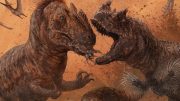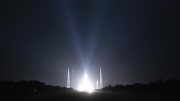
SpaceX’s Falcon 9 rocket, carrying the company’s Dragon spacecraft, lifts off the pad at Kennedy Space Center’s Launch Complex 39A in Florida on Thursday, November 9. Credit: NASA
SpaceX’s Dragon has launched on a resupply mission to the ISS, carrying scientific experiments, crew supplies, and a variety of food items.
SpaceX’s Dragon spacecraft – carrying about 6,500 pounds of critical science, hardware, and crew supplies – is on its way to the International Space Station following a successful launch from NASA’s Kennedy Space Center in Florida. The Falcon 9 rocket lifted off from Launch Complex 39A at 8:28 p.m. EST on Thursday, November 9, starting the Dragon spacecraft’s approximately 33-hour trip to the ISS for NASA.
The mission SpaceX’s 29th resupply services mission for NASA to the orbiting laboratory. It also marks the ninth flight on the Commercial Resupply Services-2 SpaceX contract and the second flight of this Dragon, which previously flew on NASA’s SpaceX 26th resupply services mission.

The first stage separates from the vehicle during NASA’s SpaceX 29th commercial resupply services mission launch on Thursday, November 9, 2023. Credit: NASA
Dragon now is safely in orbit, and its solar arrays have deployed. A series of thruster firings will help Dragon reach the space station at approximately 5:20 a.m. on Saturday, November 11. Upon its arrival, it will dock autonomously to the space-facing port of the station’s Harmony module, with NASA astronauts Jasmin Moghbeli and Loral O’Hara monitoring operations.
NASA Sending Important Science to the Space Station
The mission is carrying scientific research, technology demonstrations, crew supplies, and hardware to the International Space Station to support its Expedition 70 crew, including NASA’s ILLUMA-T (Integrated Laser Communications Relay Demonstration Low Earth Orbit User Modem and Amplifier Terminal) and AWE (Atmospheric Waves Experiment).
- Once installed on the station’s exterior, ILLUMA-T aims to test high data rate laser communications from the space station to Earth. The system uses invisible infrared light to send and receive information at higher data rates than traditional radio frequency systems. Working together, ILLUMA-T and the agency’s Laser Communications Relay Demonstration, currently in orbit around Earth, will complete NASA’s first two-way laser communications relay system.
- Also to be installed on the station’s exterior, AWE will use an infrared imaging instrument to measure the characteristics, distribution, and movement of atmospheric gravity waves, which roll through the Earth’s atmosphere when air is disturbed. Researchers also are looking at how these waves contribute to space weather, which affects space-based and ground-based communications, navigation, and tracking systems. Increased insight into atmospheric gravity waves could improve understanding of Earth’s atmosphere, weather, and climate and development of ways to mitigate the effects of space weather.

SpaceX’s Dragon spacecraft is packed with more than 6,500 pounds of science, equipment, and supplies bound for the International Space Station. Credit: NASA
Foods Launching on NASA’s SpaceX CRS-29 Mission
Hey, it’s not all science, technology, and research. The crew aboard the International Space Station also has to eat! Here is a list of foods launching on NASA’s SpaceX 29th Commercial Resupply Services mission:
- 1 fresh food kit, which will include citrus, apples, cherry tomatoes, and other items
- 2 cheese cold stowage kits, including Parmesan, Romano, cheddar, Asiago, and Gruyere
- 1 holiday bulk overwrap bag, including holiday treats such as chocolate, pumpkin spice cappuccino, rice cake, mochi, turkey, duck, quail, seafood, and cranberry sauce
- 1 shelf stable food kit, including pizza kits, hummus, salsa, and olives
- 99 bulk overwrap bags of standard menu and crew preferences
The spacecraft is expected to spend about one month attached to the orbiting laboratory before it returns to Earth with research and about 3,800 pounds of return cargo, splashing down off the coast of Florida.









Be the first to comment on "Liftoff! Dragon Safely on Its Way To Space Station for NASA’s SpaceX Mission"